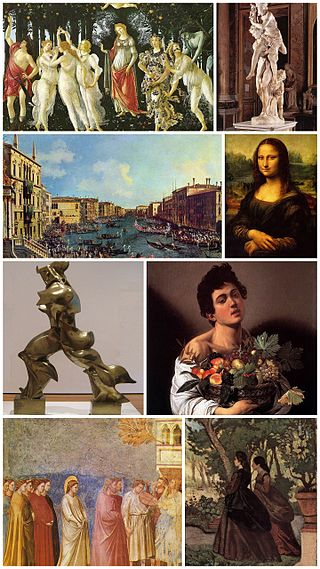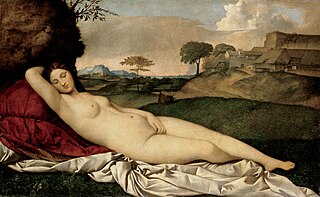Related Research Articles

The cultural and artistic events of Italy during the period 1400 to 1499 are collectively referred to as the Quattrocento from the Italian word for the number 400, in turn from millequattrocento, which is Italian for the year 1400. The Quattrocento encompasses the artistic styles of the late Middle Ages, the early Renaissance, and the start of the High Renaissance, generally asserted to begin between 1495 and 1500.

The Council of Ten, or simply the Ten, was from 1310 to 1797 one of the major governing bodies of the Republic of Venice. Elections took place annually and the Council of Ten had the power to impose punishments upon patricians. The Council of Ten had a broad jurisdictional mandate over matters of state security. The Council of Ten and the Full College constituted the inner circle of oligarchical patricians who effectively ruled the Republic of Venice.

Alessandro Leopardi was a Venetian sculptor, bronze founder and architect.

Davis School District is a school district serving Davis County, Utah, United States. Headquartered in the county seat of Farmington, it is the 61st largest school district in the United States and the 2nd largest school district in Utah with 72,987 students attending Davis schools as of 2019. It is located almost entirely within Davis County. Students attend elementary school from kindergarten to 6th grade, junior high from 7th grade-9th grade, and high school from 10th grade-12th grade.

Azzone Visconti was lord of Milan from 1329 until his death. After the death of his uncle, Marco Visconti, he was threatened with excommunication and had to submit to Pope John XXII. Azzone reconstituted his family's land holdings, taking numerous cities. He died in 1339.
Kimberly Johnson is an American poet and Renaissance scholar.

Thomas Francis Madden is an American historian, a former chair of the history department at Saint Louis University in St. Louis, Missouri, and director of Saint Louis University's Center for Medieval and Renaissance Studies.
Sir John Rigby Hale was a British historian and translator, best known for his Renaissance studies.
Guido Ruggiero is a preeminent historian of the history of Italy, from the fourteenth to seventeenth centuries. He is Professor of History and Cooper Fellow of the College of Arts and Sciences at the University of Miami, Emeritus. A master of Italian archival repositories, his work has forged new paths in the historical analysis of gender, sex, crime, violence, magic, science, and everyday life and culture. His later works also exemplify the fruits of combining the discipline of literary analysis with history. Ruggiero is one of the most prolific and groundbreaking scholars in his field. His monographs include Violence in Early Renaissance Venice, The Boundaries of Eros: Sex Crime and Sexuality in Renaissance Venice, Binding Passions: Tales of Magic, Marriage and Power from the End of the Renaissance, Machiavelli in Love: Sex, Self and Society in Renaissance Italy, The Renaissance in Italy: A Social and Cultural History of the Rinascimento, Love and Sex in a Time of Plague: A Decameron Renaissance. In addition to his own single-authored books, Ruggiero has edited with James Farr Historicizing Life-Writing and Egodocuments in Early Modern Europe ; co-edited and translated with Laura Giannetti Five Comedies from the Italian Renaissance and edited The Blackwell Companion to the Renaissance. He served as both series editor for Studies in the History of Sexuality (1985-2002) for Oxford University Press and co-editor of the six-volume Encyclopedia of European Social History for Scribner’s (2002). With Edward Muir, Ruggiero edited select articles from the Italian journal Quaderni Storici, making them accessible to English-speaking audiences in Sex and Gender in Historical Perspectives, Microhistory and the Lost Peoples of Europe, and History from Crime. Ruggiero has been the recipient of numerous fellowships and academic awards of distinction. Among them are the John Simon Guggenheim Foundation Fellowship, the Robert Lehman Visiting Professor in Residence at Harvard’s Villa I Tatti in Florence, the Rome Scholar in Residence at the American Academy in Rome, and membership in the School of Historical Studies at the Institute for Advanced Study at Princeton.
Nationality words link to articles with information on the nation's poetry or literature.

The revolt of the Cruel Fat Thursday was a revolt that broke out on Fat Thursday in 1511 in Friuli in Northeast Italy.
Brian P. Copenhaver is Distinguished Professor Emeritus of Philosophy and History at The University of California, Los Angeles. He teaches and writes about philosophy, religion and science in late medieval and early modern Europe.

Donald Weinstein was a leading American historian of the Italian Renaissance.
William Caferro is Gertrude Conaway Vanderbilt Professor of History & Professor of Classical and Mediterranean Studies at Vanderbilt University. His expertise is in medieval and Renaissance European history. His publications synthesize economic, military, social, literary, and historical trends.
Guido Beltramini is an Italian architectural historian and a curator.
John Jeffries Martin is a historian of early modern Europe, with a special interest in the histories of religion and society in the sixteenth and seventeenth centuries.

The Barbarigo Altarpiece or Enthroned Madonna and Child with Angel Musicians and Saint Mark, Saint Augustine and Doge Agostino Barbarigo is a 1488 oil painting on panel by Giovanni Bellini, now in the church of San Pietro Martire in Murano.

The Venetian Renaissance had a distinct character compared to the general Italian Renaissance elsewhere. The Republic of Venice was topographically distinct from the rest of the city-states of Renaissance Italy as a result of their geographic location, which isolated the city politically, economically and culturally, allowing the city the leisure to pursue the pleasures of art. The influence of Venetian art did not cease at the end of the Renaissance period. Its practices persisted through the works of art critics and artists proliferating its prominence around Europe to the 19th century.

Saint Mark's relics, the remains of Mark the Evangelist, are held in St Mark's Basilica in Venice, Italy.
Margaret L. King is an American historian of the Italian Renaissance and a professor emerita of history at the CUNY Graduate Center in New York.
References
- ↑ RSA Presidents
- ↑ Guggenheim Fellow: Edward Muir, 1984
- ↑ John Simon Guggenheim Memorial Foundation - 1984 Fellows Page Archived July 31, 2007, at the Wayback Machine
- ↑ Distinguished Achievement Award (Muir)
- ↑ "EDWARD MUIR HONORED BY MELLON FOUNDATION: The historian is one of three scholars to receive prestigious award". Northwestern University. Retrieved 5 August 2015.
- ↑ Fellman, Megan. "Three attend American Academy of Arts and Sciences ceremony". Northwestern University. Retrieved 5 August 2015.